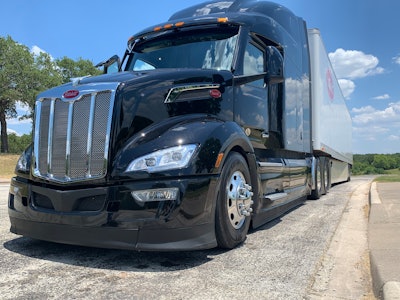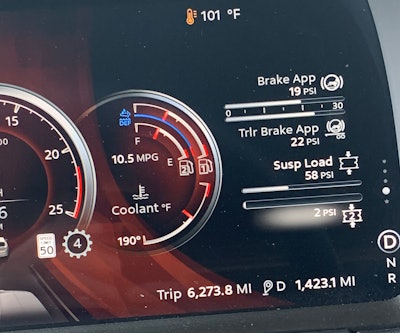When Peterbilt debuted its refreshed Model 579 last year it marked a fairly significant revamp – at least for Paccar, which has historically favored small refinements over full-blown reinvention.
The 579, indeed, is an enigma unto itself, a slick aerodynamic departure from its boxy, long-nose, flush-with-chrome family lineage.
When the Model 579 burst onto the scene a decade ago, it was a signal that Peterbilt – one of the on-highway OGs – understood that fleets' appetites for trucks were changing. "Chrome don't get you home," driver amenities and fuel efficiency were the new names of the game, and the 579 took Pete's seat at the aero table.
[Related: Test drive: Kenworth's sleek updated T680]
Since its debut in 2012, the Model 579 – now Peterbilt's on-highway flagship – has received a few of the aforementioned refinements, like the addition of the hyper-aerodynamic EPIQ package in 2014 and long-awaited integrated sleeper, UltraLoft, four years later. Beyond those, design or technology upgrades were incremental and subtle.
In a lot of ways, the new Model 579 is an all-new truck. The lone exception being that it's been around since the Obama administration.
I took Pete's retooled Model 579 on a nearly 200 mile jaunt around North-Central Texas. The black and chrome EPIQ was as much old school throwback as it was a demonstration of modern technology and freight efficiency.
On the power side, the new MX-13 engine gets a 2% fuel economy bump, while the MX-11 will see a 2.5% bump as of the 2021 model year. As for the rest of Pete's updated Model 579s, technology and aerodynamics do the heavy lifting.
All-new (but not really)
 Boasting a 7% fuel economy improvement over prior generation models, the new Model 579 is the most aerodynamic and fuel-efficient Peterbilt model built to date.
Boasting a 7% fuel economy improvement over prior generation models, the new Model 579 is the most aerodynamic and fuel-efficient Peterbilt model built to date.
Boasting a 7% fuel economy improvement over prior generation models, the new Model 579 is the most aerodynamic and fuel-efficient Peterbilt model built to date. The truck appears noticeably more narrow, the hood is lower, and the aerodynamic mirrors are a bit shorter. Standard halogen headlamps have been improved, and heated LED headlights are available.
Visibility from the driver's seat is excellent, but the shorter side mirrors take some getting used to. On the outside, the 579 appears to have the long snout you'd expect of a legacy tractor, but when you hop inside it basically disappears.
One of the more subtle design changes – if not the only subtle one – is the integration of Pete's iconic "bird" hood ornament/pull handle, which has been accented in the hood's side vents and on the rear wall.
A new three-piece front bumper integrates the forward radar cover for collision mitigation with a larger aerodynamic air dam. Improvements to the aero mirrors, fairings, side skirts and closeouts help improve the overall aerodynamic shape and an A-pillar vane slings airflow around the windshield to reduce friction, delivering a 10% noise reduction in the cabin.
You can maintain a conversational voice level in the cab at highway speed. In fact, I found that when road noise inside the cab spiked, it was usually coming from the vehicle beside me. The pillar-mounted vanes are so effective at moving air down the side of the truck and trailer that when you lower the window, the noise level barely increases, and the air inside the cab is calm – even at 60-plus mph.
It was over 100-degrees for the duration of the drive, so the window didn't spend a lot of time down. Peterbilt also designed its upper dash and door panels to be glare resistant, keeping the sun, which was mercilessly beating us down, from washing out the glass.
Technology touches
A brightly lit 15-inch digital display replaces a traditional analog gauge cluster. It's fully customizable, allowing drivers to pick and choose how much (or how little) information they want to see. This is probably my favorite feature. I like having a lot of driving data in front of me: air system pressure, engine temp, etc., and I like not having to peek to the wing panel to see it. I can see everything I want to see with a quick glance down between the yokes. I also like that the display is infinitely customizable, so if I drop my trailer I can hide trailer air pressure, or I can cycle something else into that spot on the screen.
I appreciate the old-school look and reliability of analog gauges as much as the next guy, but the digital display is simply a better way to package all this information. The screen prioritizes alerts. If the coolant level is low, for example, it's brought front and center on the screen, even if the alert category isn't something the driver has selected for on-screen monitoring.
And, yes, there are redundancies in place, and, no, one blown fuse won't black out the entire screen and send you hurdling down the highway at unknown speeds with unknown air pressure levels.
The digital display can also perform a systems check – a pre-trip inspection of sorts – on 13 systems, displaying a green checkmark with each passed test. Post trip, a detailed trip information screen provides a breakdown of noteworthy metrics from the most recent journey.
The new Model 579 features an Advanced Driver Assistance System (ADAS) with integrated camera and radar technology, including collision mitigation, overspeed alerts and lane-keep assist. Lane-keep assist is a handy feature considering that one in five truck fatalities are linked to unintended lane departures, according to Bendix.
Lane keeping, road crown and crosswind correction inputs are made through the steering column’s electric motor, so you barely notice it until it activates and gently nudges you back into your lane. Overall, steering has a very light and responsive feel.
On-highway manners, back office performance
 Equipped with an MX-13 (455 hp and 1,650 ft-lb torque) and 12-speed Paccar transmission, my 579 EPIQ and I routinely were getting more than 10 mpg through the mostly flat Texas countryside while grossing out around 66,000 pounds.
Equipped with an MX-13 (455 hp and 1,650 ft-lb torque) and 12-speed Paccar transmission, my 579 EPIQ and I routinely were getting more than 10 mpg through the mostly flat Texas countryside while grossing out around 66,000 pounds.
The interior is plush, the 2.1 meter cab is spacious and comfortable and the accents and design touches are in line with something you'd find in a premium trim-level automobile.
Equipped with an MX-13 (455 hp and 1,650 ft-lb torque) and 12-speed Paccar automated manual transmission, my 579 EPIQ and I routinely were getting more than 10 mpg through the Texas countryside while grossing out around 66,000 pounds. At one point I was holding 10.5 mpg (helped by a 2.64 rear axle ratio), and I never once used adaptive cruise.
Alas, I managed to drag that down below 10 mpg with the final mile trek back to the terminal. Such is the life of the American trucker: the fuel gods giveth and the fuel gods taketh away.
I'm not a hyper-miler. I wasn't putting any effort into fuel economy. I was piloting a reasonably loaded truck – one with a 235-inch wheel base and an 80-inch UltraLoft sleeper – and I was still getting double digit miles per gallon. If there was ever a testimony that, "If I can do it, so can you," this is it.
The EPIQ package was born from Peterbilt’s involvement with the SuperTruck program, a government program that funded OEM and component research in technologies to boost commercial truck fuel economy, and that experience has translated perfectly to production models.
The wheel well closeouts, ground skirts and tandem fairings that make the truck slippery do so without exposing it unnecessarily to curb and ground strikes.
I know drivers often feel that there's a power-for-performance tradeoff when it comes to fuel efficiency, but that wasn't the case at all with the 579. The MX-13 had no trouble dragging the load, regardless of how the terrain changed.
The new Model 579 doesn't make a lot of sacrifices in offering the kind of performance and amenities that drivers like and the efficiency and technology that the back office likes. It is, quite frankly, the perfect blend of old and new school.
from Overdrive https://ift.tt/p4jkTUh



Sourced by Quik DMV - CADMV fleet registration services. Renew your registration online in only 10 minutes. No DMV visits, no lines, no phone mazes, and no appointments needed. Visit Quik, Click, Pay & Print your registration from home or any local print shop.

No comments:
Post a Comment